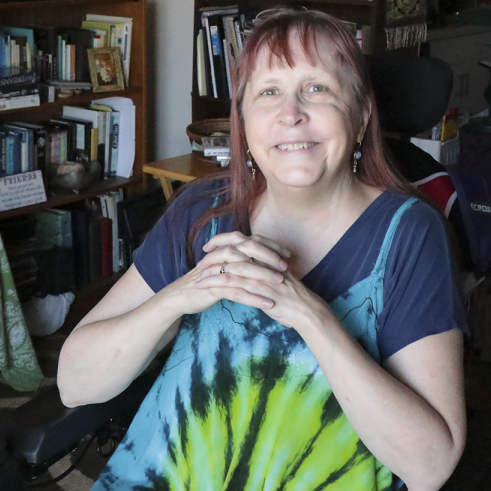A Rolling Perspective: Fear, The Mind-Killer

--Bene Gesserit "Litany Against Fear"
"I must not fear. Fear is the mind-killer.
Fear is the little-death that brings total obliteration."
The “Litany Against Fear” is from one of my all-time fave books and movies, Dune by Frank Herbert. While the novel is considered fantasy, I’ve learned for myself that fear does indeed kill the mind—or at least blocks the path to its creative section, the one that provides alternatives to fight, flee, or freeze.
Not knowing the “weirding way” of the Bene Gesserit, I rely instead on what I’ve learned from Byron Katie: stress comes from harboring an untrue belief. Find the belief, question it for relief. To wit:
- Is it true?
- Can I be absolutely sure it’s true?
- How do I feel when I believe X is true?
- How would I feel if it were impossible to have the belief?
And then I turn the belief on its head. Simple!
Yet recently, as I worked on articles, I’ve remained stressed even after BK-ing what I thought was my unquestioned belief: The problems faced by disabled and senior persons are so great, chances are I’ll end up either homeless or trapped in this tiny town and unable to look after myself. Do you think I’m overdramatic? Before you judge, jot down your fears and see how reasonable they are! If you’re able to sit and write, you’re not in the middle of anything remotely life-threatening.
Mind is a funny thing. It searches for whatever information will back up our beliefs, no matter how distanced from reality. Thus, the research I kept coming across (that would surely scare the socks off even a seasoned Bene Gesserit) only proved my fears were “real.” And when fear took over, it killed the ability to create solutions.
I’ve lost track of how many articles stress that housing and transportation are the two biggest challenges facing a society where ten thousand persons a day turn sixty-five. In 2018, half of those who were 65+ were disabled. Half! Yikes. Across all age groups, disabled persons were the least likely of all to be employed. And if they were, they earned far less. Surely these stats justified my fears?
Suddenly I realized I’d been questioning the wrong belief. It wasn’t the twin specters of dependence and indigence I feared, but a two-fold belief that (1) “no one” knew how awful things really were for seniors and disabled persons, and (2) if no one was aware, that automatically meant no one was doing anything. (Okay, I do tend to think in extremes. It comes in handy for fiction writing, though.) To add more stress, I felt I had to singlehandedly come up with solutions to these mega-challenges.
Once I got clear, other websites and different articles came my way. I read about the World Health Organization’s aging initiatives and then discovered that our very own AARP came on board with WHO’s programs back in 2012; they now help communities of all sizes accommodate their aging citizens in a respectful, empowering way. I discovered other programs, too, such as the Aging in Place Initiative and Partners for Livable Communities.
But I was very good at worrying, as I’d had so much practice. Another thought gnawed: but…but…but how can communities afford to implement these great ideas? Federal programs’ budgets have been slashed to the point that even large cities no longer have funding, let alone small ones. While I sensed the federal “one-size-fits-all” approach hasn’t been very effective, it was better than nothing.
And here’s when I started doing a Happy Dance instead of the Fear Fandango. The AARP is just one of the organizations helping individual communities plan for their specific needs free of charge. Towns can get grant funding for aging-in-place projects, too. Best of all, you can start the process yourself! The World Health Organization’s website says: “Any city or community that is committed to creating inclusive and accessible urban environments to benefit their ageing [sic] populations is welcome to join.” And they provide the forms to do so, along with lists of organizations engaged in implementing the process in individual countries. I can start the ball rolling right here in my little town—as can you. There’s no need to panic.
Fear lurks in the lower, animal brain, and is the part that constantly looks for danger (unconsciously; we are unaware of its associations, only its consequences) and decides whether we fight, flee, or freeze. Fear has the effect of blinders, narrowing our field of vision quite literally. When terrified, we are unable to digest either food or new information. This blinkered vision, as well as it serves us when we have an immediate threat to our lives, is not the best way to approach everyday life. We need our higher brain for best results.
Whether we recite the Bene Gesserit’s Litany, engage in Byron Katie’s inquiry, or employ another method, once we’re calm we can turn to our infinitely creative higher brain for solutions we can share with our community. Our input is critical to the programs that can transform our country and the lives of all—not just the elderly or disabled.
Don’t be afraid to speak up, please.
Jennifer Holland taught herself to read and write at age four and has been doing both ever since. Minnesota-born and Wisconsin-bred, she nonetheless inherited the Irish perchant for travel. Despite the shoestring budget, she visited a dozen countries before her diff-ablement, and even lived in Ireland for nearly fifteen years. Her encounters with other cultures inform the quirky insights into human behavior that find their expression in her poetry, novels, and non-fiction works. When she's not reading or writing, she enjoys chair yoga, video chats with her children and gradchildren, and living happily with MS on a tiny fixed income.


